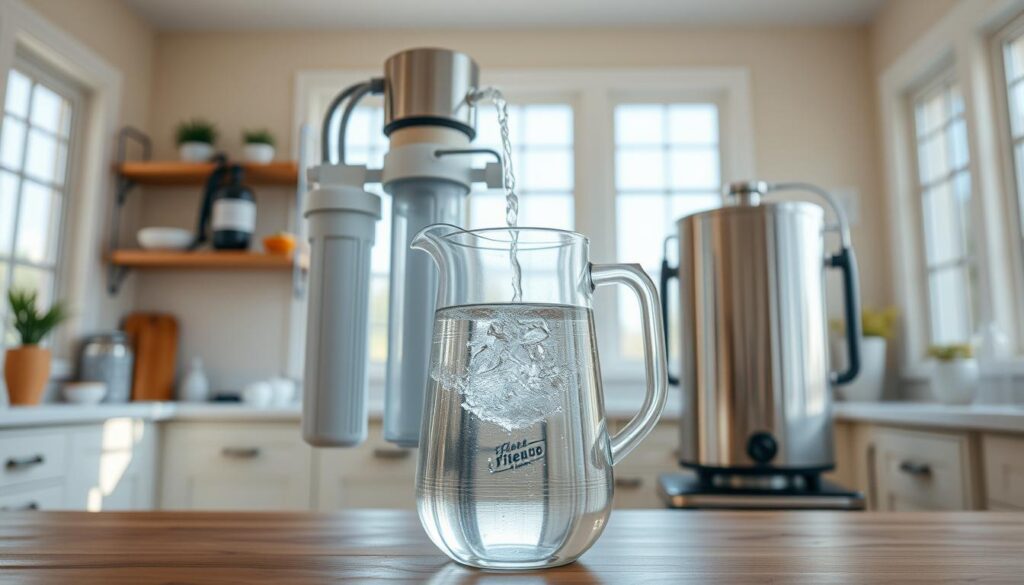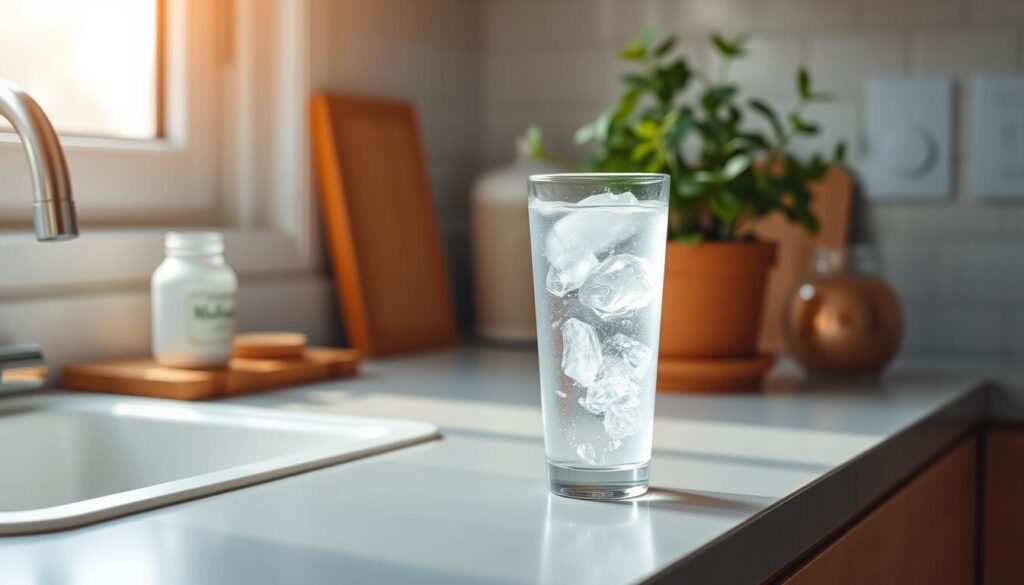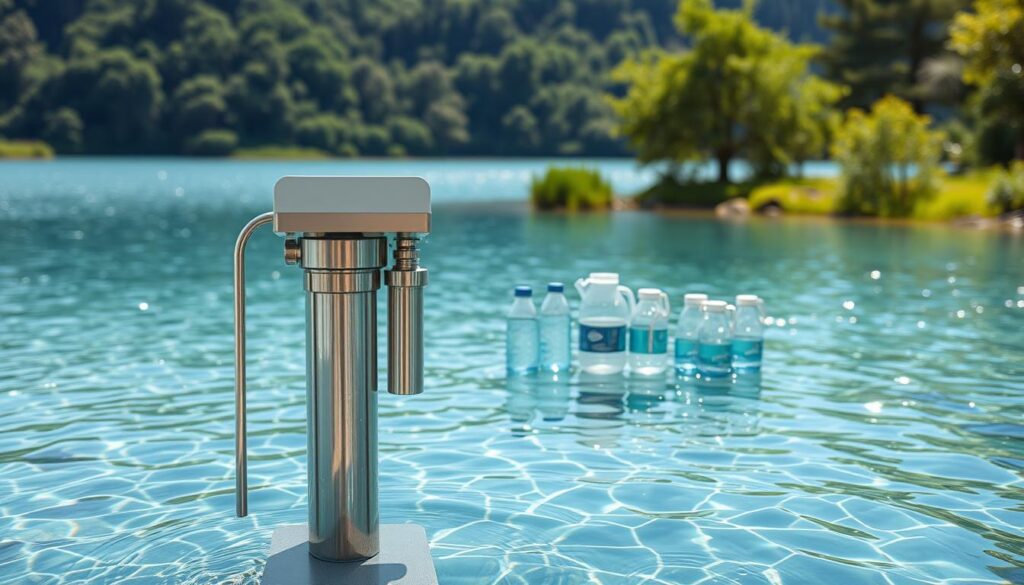Having clean drinking water is key. I’ve worried about my tap water quality. Making a DIY water filtration system at home is easy and works well.
In this guide, I’ll show you how to purify water at home. With growing worries about water quality, it’s important to have a way to clean it.
Key Takeaways
- Learn how to create a DIY water filtration system at home.
- Understand the step-by-step process of purifying water.
- Discover the materials needed for the filtration process.
- Get insights into the science behind the filtration method.
- Improve the quality of your drinking water with a simple DIY solution.
Introduction to DIY Water Filtration
With growing worries about water quality, I looked into DIY water treatment. Creating a homemade water filter is a good way to clean water, even in emergencies.
DIY water filtration has many perks. It’s cheaper and lets you control your water’s quality. Knowing about water contaminants and DIY filtration helps people manage their water better.
Why I Chose to Filter My Water
I chose to filter my water because tap water can have harmful stuff. This includes heavy metals, bacteria, and viruses. These can hurt your health, so purifying water is key.
Benefits of DIY Solutions
DIY water filtration has many benefits. Here are a few:
- It’s cheaper than buying bottled or filtered water
- You can make it fit your needs
- It’s better for the environment because it’s reusable
Studies show that DIY water filtration can work as well as commercial systems if done right.
Understanding Water Contaminants
Water contaminants fall into three main groups: biological, chemical, and physical. Knowing these groups helps you make a better DIY water filter.
| Contaminant Type | Examples | Health Risks |
|---|---|---|
| Biological | Bacteria, viruses, parasites | Gastrointestinal diseases, infections |
| Chemical | Heavy metals, pesticides, industrial chemicals | Cancer, neurological damage, reproductive issues |
| Physical | Sediments, particulates | Reduced water quality, aesthetic issues |
Knowing about contaminants and their risks helps you make a better DIY water treatment system.
Essential Tools and Materials
Starting a DIY water filtration system begins with the right supplies. You’ll need a few basic items that are easy to find.
Basic Supplies I Used
I began with a plastic bottle, cotton balls, sand, charcoal, and gravel. These items are common and cheap. The plastic bottle holds the system, and cotton balls catch big particles. Sand and gravel filter out smaller stuff, and charcoal removes chemicals and improves taste.
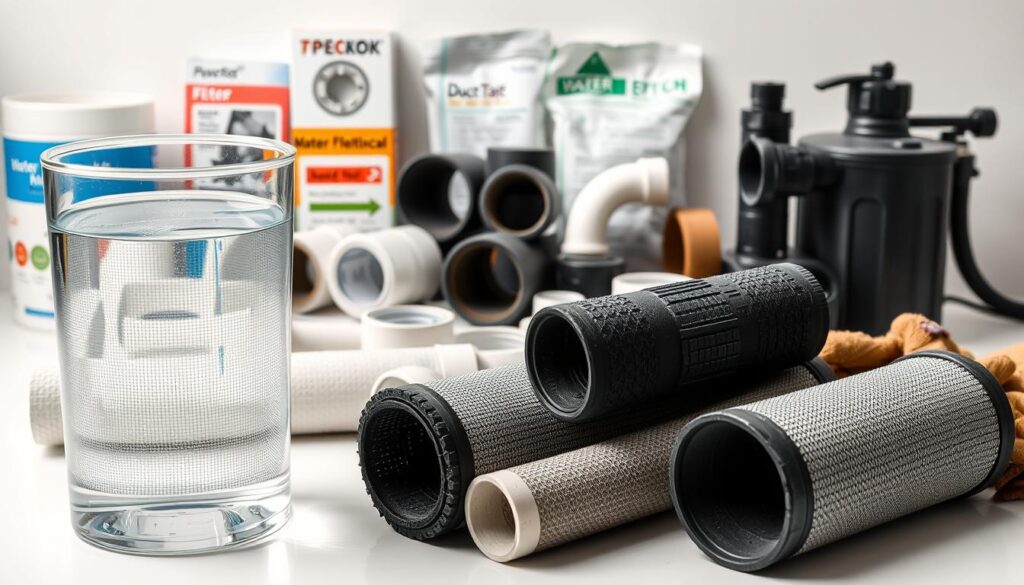
Advanced Tools for Better Filtration
For better filtration, you might want advanced tools. A water pump boosts flow, and filters like ceramic or membrane add extra purification. These tools are great for very dirty water.
Where to Find Affordable Materials
DIY water filtration is budget-friendly. You can find basic supplies at hardware stores or around your home. For example, plastic bottles and sand are easy to get. Charcoal is available at camping stores or online.
Choosing the right materials and tools is key to a good DIY water filtration system. Whether you need something simple or more complex, knowing each part’s role is important.
Types of DIY Water Filters
DIY water filtration offers many options. You can pick from various methods and materials. Each technique has its own benefits and uses.
Activated Carbon Filters
Activated carbon filters are great for removing chemicals and improving water taste. They work by catching contaminants in the carbon pores.
Benefits of Activated Carbon Filters:
- Effective against chlorine and volatile organic compounds (VOCs)
- Improves the taste and odor of water
- Relatively inexpensive and easy to replace
Sand and Gravel Filtration
Sand and gravel filtration is good for removing particles from water. It uses a simple setup of sand and gravel layers in a container.
“Slow sand filtration has been used for centuries as a reliable method for purifying water.”
This method is effective against suspended solids and some biological contaminants.
Ceramic Filters
Ceramic filters are great at blocking bacteria, viruses, and other pathogens. They are made from ceramic with small pores. This traps contaminants while letting clean water through.
| Filter Type | Effectiveness | Cost |
|---|---|---|
| Activated Carbon | High against chemicals and taste | Low to Moderate |
| Sand and Gravel | High against particulate matter | Low |
| Ceramic | High against bacteria and viruses | Moderate to High |
Step-by-Step Guide to Building a Simple Filtration System
You can make a DIY water filter with basic materials. This guide will show you how, from setting up your container to checking the water quality.
Preparing the Filtration Container
Start by getting your container ready. Use a clean, big plastic bottle or container. Cut the bottom off to make a funnel shape. This will be where your filtration media goes.
Key steps to prepare the container:
- Clean the bottle with soap and water.
- Rinse it well to get rid of soap.
- Cut the bottom off to make an open end.
Layering the Filtration Media
The success of your DIY filter depends on the media layers. You’ll need sand, gravel, and activated carbon.
The layering process involves:
- Start with gravel at the bottom to catch big particles.
- Add sand on top of gravel for smaller particles.
- Use activated carbon to remove chemicals and improve taste.
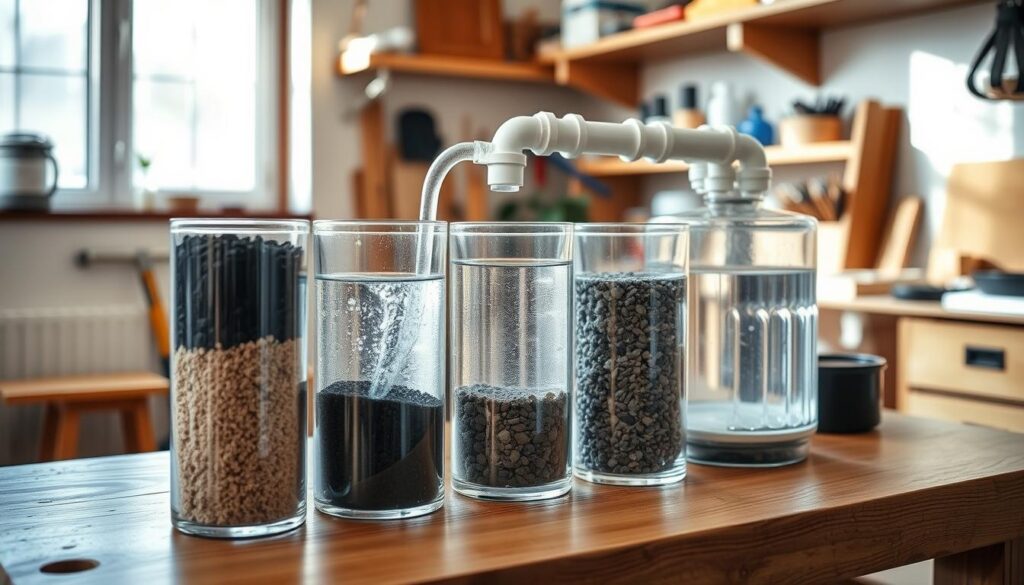
Testing the Water Post-Filtration
After setting up your filter, test the water quality. Use water testing kits or send a sample to a lab for detailed analysis.
Some parameters to check include:
- pH levels
- Presence of heavy metals
- Bacterial contamination
By following these steps, you can make a simple yet effective DIY water filter. It will give you clean drinking water at home.
Maintenance of My DIY Water Filtration System
Maintaining my DIY water filtration system is important. It keeps the water clean and safe to drink. Regular care is key for its long life and good performance.
Cleaning and Replacing Filters
Cleaning and replacing filters is a big part of keeping my homemade water filter in top shape. Filters get clogged with dirt and stuff, making them less effective. I clean them often and replace them when needed to keep the water clean.
“Regular maintenance is key to ensuring your water filtration system works effectively,” as emphasized by water quality experts. This makes the water taste better and keeps it safe to drink.
Signs It’s Time to Change the System
There are signs that tell me it’s time to change my DIY water filtration system. If the water flows slower, has more sediment, or tastes or smells different, it’s time for a check-up.
Also, if the water filters slower than before or the water pressure drops a lot, it might be time for a new system.
Regularly Testing Filtration Effectiveness
I test my DIY water filtration system regularly to make sure it’s working right. I check the water quality before and after it goes through the filter. This helps me see if it’s catching all the bad stuff.
By testing it often, I can spot problems early and fix them. This keeps my water purification at home system working well.
Cost-Effectiveness of DIY Water Filtration
DIY water filtration is very cost-effective. It lets people purify their own water without spending a lot. This is much cheaper than buying commercial systems.
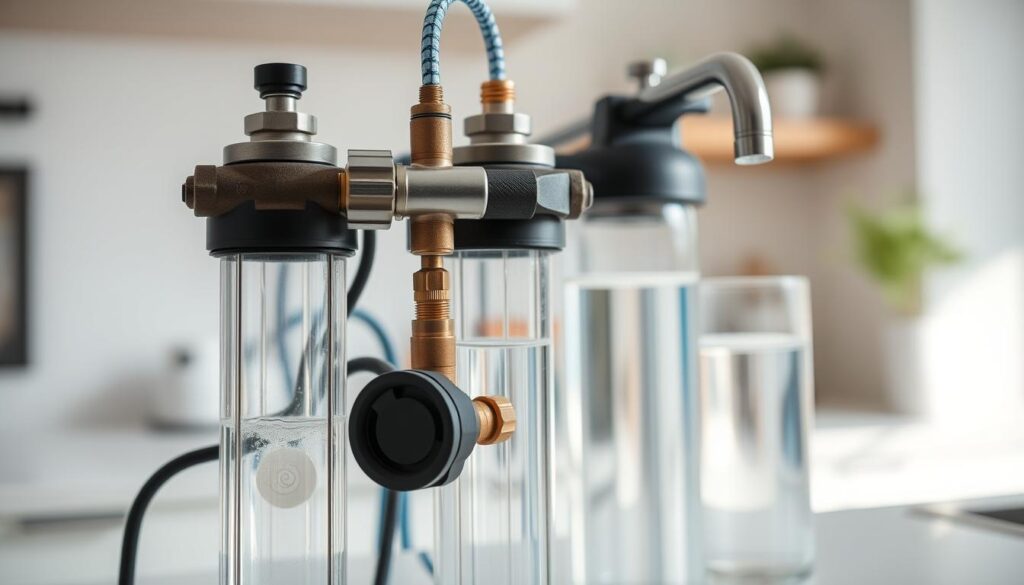
Comparing Store-Bought vs. DIY Solutions
Commercial water filters can be pricey. They cost from tens to hundreds of dollars. On the other hand, DIY water treatment is cheap. You can use common items to make a filter.
For example, making a basic filter with activated carbon, sand, and gravel costs only $20-$50. This is much less than many commercial filters.
Long-Term Savings and Benefits
DIY water filtration saves money over time. The upfront cost is lower, and maintenance is cheaper too.
- Less money spent on replacement filters
- DIY systems need little upkeep
- You can use household items for filtration
Initial Investment vs. Ongoing Costs
The cost to start a DIY water filter can vary. But, the ongoing costs are very low. This is different from commercial systems, which need regular filter replacements.
DIY systems help keep costs down. For instance, replacing or cleaning filters is much cheaper than buying new ones for commercial systems.
- Look at the initial cost of materials and setup.
- Think about the cost of maintenance and replacement parts over time.
- Compare the total cost-effectiveness based on these points.
Enhancing Filtration with Additional Techniques
Building a DIY water filtration system is just the start. There are other ways to make your drinking water even cleaner. These methods can boost the purity of your water.
Boiling Water for Extra Purity
Boiling water is a simple yet effective way to purify it. Boiling water kills bacteria, viruses, and other pathogens that filters might miss. The Centers for Disease Control and Prevention (CDC) says boiling is a reliable way to make water safe.
You only need a pot and a heat source to boil water. It’s easy and doesn’t require much.
“Boiling water is a simple, effective way to kill pathogens that can cause illness.”
Using UV Light for Added Protection
UV light is another way to purify water. UV light can kill bacteria, viruses, and other microorganisms. This method is great because it doesn’t change the water’s taste or chemical makeup.
The World Health Organization (WHO) recognizes UV light as a safe way to disinfect water.
Adding Mineralization After Filtration
Adding minerals to filtered water can make it taste better and be more nutritious. This is done by passing the water through a mineral-rich medium, like coral sand or mineral stones. It can increase the water’s mineral content, making it safer and more enjoyable to drink.
Some people use remineralization filters for this purpose. These filters are made to add minerals back into the water.
By adding these techniques to your DIY water filtration system, you can make your drinking water even cleaner. Whether you boil, use UV light, or add minerals, each method has its own benefits. You can choose what works best for you.
Common Mistakes to Avoid in DIY Filtration
Building a DIY water filtration system can be rewarding. But, it’s key to avoid common mistakes that can make it less effective. When I started, I learned that knowing and avoiding these errors is as important as the process itself.
One big mistake is not doing water quality tests. It’s vital to test the water before and after filtration. Without these tests, you might not know if your water is clean.
Overlooking Water Quality Tests
Water quality tests are essential to know what your system needs to remove. Ignoring these tests can give you a false sense of security. Regular testing helps you find the right filtration media and check if your system works well.
- Use water testing kits to identify contaminants.
- Test water before and after filtration.
- Adjust your filtration system based on test results.
Using Improper Materials
Another big mistake is using the wrong materials. Using non-food-grade materials can make your water unsafe. Make sure to pick materials that are right for water filtration.
Some important things to consider include:
- Choose materials that are durable and won’t get damaged by water.
- Make sure all materials are safe for drinking water.
- Avoid materials that can hold bacteria or other contaminants.
Ignoring the Importance of Maintenance
Maintenance is key for any DIY water filtration system. Not doing maintenance can make your system less effective over time. It’s important to clean and replace filter media regularly.
To keep your homemade water filter working well:
- Regularly clean the system as the manufacturer says.
- Replace filter media when needed or when water quality drops.
- Watch how the system performs and make changes if needed.
By avoiding these mistakes, you can make sure your DIY water filtration system works well and safely. This way, you’ll have clean drinking water for a long time.
Real-Life Experiences with My Water Filtration
Thinking back on my DIY water filtration journey, I remember many real-life experiences. These have helped me understand water purification at home. Setting up a DIY water filtration system can be rewarding, with both successes and challenges.
Success Stories from Friends and Family
Many friends and family members have tried DIY water filtration systems. Their stories are truly inspiring. For example, a friend in a rural area greatly improved her well water’s clarity with a simple sand and gravel system.
Another friend, who loves camping, uses a portable DIY system. He says it makes the water taste and smell better, making his camping trips more fun.
Personal Challenges Faced
I’ve faced some challenges in my DIY water filtration journey. Choosing the right materials and designing an effective system was tough. It took a lot of research and trial and error to get it right.
Keeping the system clean and replacing filters regularly has been hard. Sometimes, I had to fix issues like clogged filters or leaks. It took patience and persistence to solve these problems.
Lessons Learned Throughout the Process
I’ve learned a lot from this journey. Regular maintenance is key. Testing water quality and keeping the system in good shape is essential for its effectiveness.
I’ve also learned that DIY water filtration isn’t one-size-fits-all. Different water sources and contaminants need different solutions. Being open to adjusting the system as needed has been important for its success.
In summary, my DIY water filtration experience has been both enlightening and challenging. It has taught me a lot about water purification at home.
Environmental Impact of DIY Water Filtration
DIY water filtration has many benefits for the environment. It helps reduce waste and promotes green living. By using homemade filtration methods, we can cut down on bottled water and plastic waste.
Reducing Plastic Waste with Reusable Solutions
One big plus of DIY water treatment is less plastic waste. Reusable filters and containers help a lot. For example, one person can save up to 156 plastic bottles a year.
Here’s a table showing the difference between bottled water and DIY systems:
| Category | Bottled Water | DIY Filtration |
|---|---|---|
| Plastic Waste per Year | 156 bottles | Minimal (filter replacements) |
| Carbon Footprint | High (transportation) | Low (local setup) |
| Cost per Liter | High ($1-$2 per liter) | Low ($0.01-$0.10 per liter) |
Sustainable Practices in Filtration
DIY water filtration focuses on being green. It uses local materials and aims for long life and easy upkeep. For more on green practices, check out Understanding the Environmental Impact of Water.
Encouraging Eco-Friendly Habits
DIY water filtration helps us reduce our environmental impact. It also inspires others to live greener. As more people use eco-friendly water treatment, our planet benefits a lot.
In summary, DIY water filtration is great for the environment. It cuts down plastic waste, supports green living, and encourages others to do the same. I’m excited to share more about DIY water filtration and inspire others to join in.
Conclusion
Reflecting on my DIY water purifier journey, I’m sure it’s a smart move. It’s a great way to have safe drinking water at home. By controlling your water quality, you lower the risk of waterborne illnesses and get cleaner water.
Empowering Self-Sufficiency
Creating a DIY water purifier boosts your self-sufficiency and supports a green lifestyle. For tips on finding safe drinking water, check out Survivalist Bottles. They share useful info on water purification.
Future Filtration Projects
I’m looking forward to sharing my next water filtration projects with you. DIY water filtration improves your health and helps the environment. It’s a win-win for everyone.
FAQ
What materials are needed to build a DIY water filtration system?
You’ll need a plastic bottle, cotton balls, sand, charcoal, and gravel to make a DIY water filter. These items are easy to find and won’t cost much. You can also use advanced tools to improve the filter, but these basics are enough to start.
What are the different types of DIY water filters I can build?
You can make different kinds of DIY water filters. For example, you can use activated carbon, sand and gravel, or ceramic filters. Each one is good at removing different things from the water, like chemicals or bacteria.
How do I maintain my DIY water filtration system?
Keeping your DIY water filter in good shape is important. Clean and replace the filters regularly. Also, watch for signs that the system needs to be changed. Testing the water quality will help you know if the filter is working right.
Is DIY water filtration cost-effective compared to store-bought solutions?
Yes, making your own water filter can save money. It costs less upfront and in the long run. DIY filters are a smart choice for saving money and getting clean water.
Can I enhance my DIY water filtration system with additional techniques?
Absolutely, you can make your DIY water filter even better. Try boiling the water, using UV light, or adding minerals after filtering. These steps can make the water even cleaner and taste better.
What are some common mistakes to avoid when building a DIY water filtration system?
Don’t forget to test the water quality and use the right materials. Also, don’t ignore the need for regular maintenance. Knowing these mistakes can help you make a better filter.
How can I ensure my DIY water filtration system is environmentally friendly?
To make your DIY water filter eco-friendly, use things you can reuse. Choose sustainable methods and encourage others to do the same. This helps reduce waste and is better for the planet.
What are some additional methods for purifying water at home?
Apart from DIY filters, you can also boil water, use UV light, or add minerals. You can use these methods alone or together with a DIY filter. This way, you can get water that’s as clean as possible.
How often should I test the effectiveness of my DIY water filtration system?
It’s important to test your DIY water filter often. How often depends on the type of filter and the water it’s filtering. Regular testing keeps your water safe and clean.
Can I use a DIY water filtration system for emergency preparedness?
Yes, a DIY water filter is great for emergencies. It lets you have clean drinking water when you need it most. This is very useful in case of emergencies or natural disasters.

